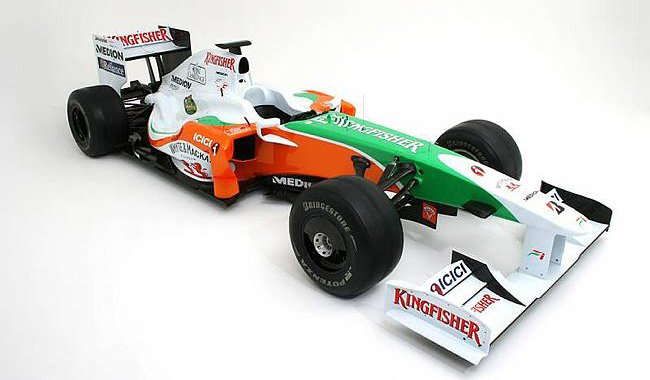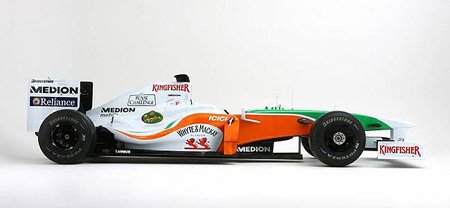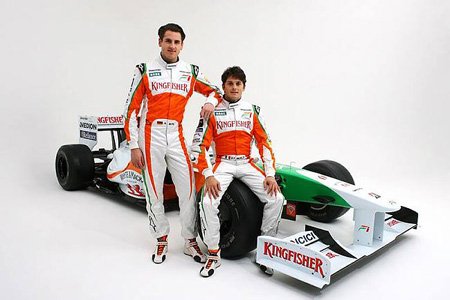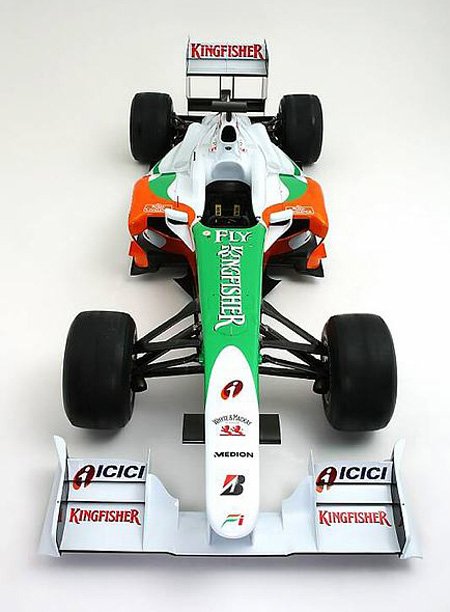
(more images below)
The team released the following statement:
The Force India Formula One Team's 2009 challenger, the VJM02, will make its track debut today at the Circuit de Jerez, southern Spain, with Giancarlo Fisichella at the wheel.
The VJM02 represents a radical departure from the design ethos of its predecessor, the VJM01. This year's contender will incorporate a Mercedes-Benz V8 engine and McLaren gearbox, thanks to a new partnership forged in November 2008 between McLaren, Mercedes and Silverstone-based Force India. Fundamental changes in the technical regulations, meanwhile, have led to a major overhaul of aerodynamics, the optional addition of KERS and a compulsory return to ungrooved 'slick' Bridgestone Potenza tyres.
Dr Vijay Mallya, chairman and team principal of Force India, is confident this year's challenger will be the one to bring increased success to his young team after a frustrating points-free debut season, 'To be brutally honest, I would not be happy if we didn't show some much improved, and much needed, performance this season.
'What we really set out to do over the winter was to put in place structures, procedures and partnerships that would give improvement, but crucially, no excuses. By using the same drivetrain as another team, Force India now has a high-level benchmark of its own performance. If performance relative to McLaren - the 2008 championship winning team - is low, there are only a reduced number of variables that need to be analysed and understood.'
Dr Mallya's aspirations are resolutely clear: 'I would like to see a strong start, rising to points mid-season and a definite improvement in qualifying. Regular points finishes should be the aim.'
The VJM02 has been designed in-house at the team's UK facility by a tight-knit unit led by design director Mark Smith and technical director James Key, who have in turn been supported by a small team spear-headed by 2009 project leader Ian Hall.
In addition to the various challenges in interpreting a brand new set of technical regulations, the team has also condensed its development into just five months: the period between the McLaren deal being signed in November and the start of the season. It's been no mean feat to get everything ready, particularly with the team not turning a wheel between its last test in November and the debut of the new car - almost 100 days.
Design director Mark Smith explains the challenge the team has faced, 'When we confirmed the partnership on 10 November 2008 we had to adapt our plans fairly significantly. It's not just a case of getting the new parts and installing them; when we changed the gearbox, it had slightly different suspension mountings and when we changed the rear suspension there was a necessary change on the front.
'Normally you would have started in August, so we have had to compress everything into five months. Everyone has really worked hard to make it work and we've got a potentially better package, so the change has been a positive rather than a negative.'
This year, Dr Mallya will be hoping the positives far outweigh those negatives: 'This is the year we have to deliver. We are not here to make up the numbers, I want to be pushing all the way.'
Giancarlo Fisichella will complete testing duties today and 2nd March, with Adrian Sutil getting his hands on the VJM02 for the two final days of the test.



